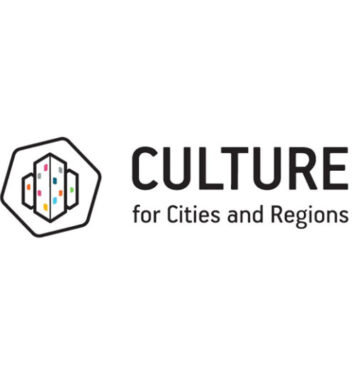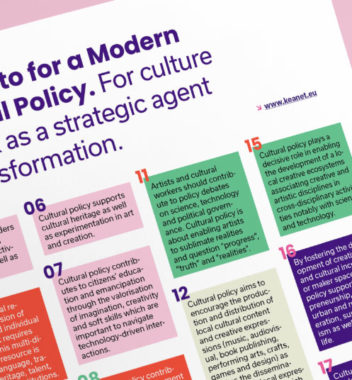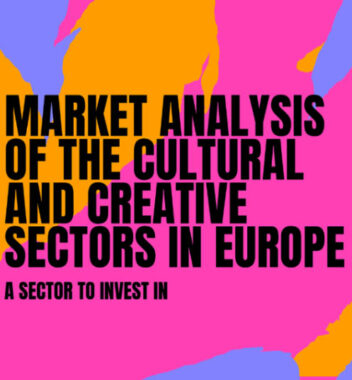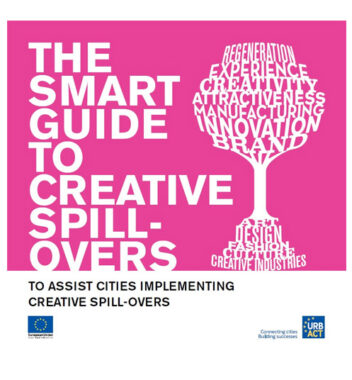
The European Commission (EC) has recently issued its proposal for the 2014-2020 Cohesion Policy. With a budget of over € 376 billion for the new funding period, European regional policy represents over one-third of the EU budget. However, access to EU regional funding will be faced with much more demanding requirements and a more result-focused approach than the current one. EU funds will be released to regions and cities subject to performance or on the condition that, among others, Smart Specialisation Strategies[1](RIS3) exist.
Regions and cities have used 1.7% of structural funds’ budget for the period 2007-2013 to support culture and creative industries (CCIs), either to promote cultural heritage and tourism, to revitalise local economies or to enhance sustainable urban development.
The Commission is calling on regions to further invest EU regional policy funds in CCIs. CCIs are considered as a catalyst for structural change as they can boost local economies, create new and sustainable jobs, have important spill over effects on other industries and enhance the attractiveness of cities and regions (“Regional Policy contributing to smart growth in Europe”, 2010). Regions have been invited to develop “strategies for smart specialisation” (RIS3) which should embrace a broad concept of innovation including not only investment in research or the manufacturing sector, but also in design and creative industries (Smart Specialisation Platform Guide 2011). The European Commission is
inviting regional authorities to integrate CCIs in innovation strategies for smart specialisation via a “creative ecosystem” that promotes traditional cultural assets as well as CCIs’ spill over effects into the local industry.
The Benchmarking Raster: a practical tool to assess the economic impact of local CCIs policies
The INTERREG IVC CREA.RE network has commissioned KEA to create a benchmarking raster (the raster), meaning a set of indicators to measure policies focusing on local economic development through CCIs. CREA.RE comprises 12 local and regional public authorities from 10 different EU countries[2]. It aims to better involve the creative sectors in the development of European regions and urban centres.
The raster is a practical and user-friendly tool that allows regional and local authorities to assess the economic impact of policies supporting the development of CCIs. Adapted to the specifics of CCIs and mainly focused on policy instruments which impact on economic and business development[3] (as opposed to social and cultural impacts), it may be used both in small and large urban centres.
The benchmarking raster echoes the European Union’s call for data supporting the design of evidence-based policies (“Green Paper – Unlocking the potential of cultural and creative industries”, Smart Specialisation Platform Guide 2012, umbrella programme proposal “Creative Europe” for CCIs). Evidence is needed to justify and prioritise public spending, especially in a time of crisis.
23 indicators have been developed in relation to 4 categories of support measures:
- Infrastructure and clustering/networking to support business establishment and trading (e.g. low rent spaces, technological equipment, incentive schemes fostering linkages, etc.);
- People, competences and entrepreneurship to support the development of business skills as well as to set up tools facilitating access to finance (e.g. training on business plans, venture capital funds, loan schemes, etc.);
- Incubation to encourage startups;
- Measures relating to governance stemming from the way policy measures are established and implemented.
The indicators are classified as follows:
- 3 key performance indicators on the overall contribution of support measures to establishing a creative ecosystem.
- 16 indicators for support measures or on the outputs and outcomes of the measures.
- 4 indicators for governance to assess how policies for CCIs are established and implemented.
A tool to develop Smart Specialisation Strategies and raise EU funds
The benchmarking raster is a useful tool for regions to access EU structural funds. It provides a policy evaluation tool that strengthens the content of funding application. Indicators showing the effectiveness of governance structures and the efficiency of management process reinforce the credibility of projects. This is important as EU structural funds are due to become more accessible to projects subject to management capacity (conditionality).
Evidence of the impacts of CCIs’ investment will also support the inclusion of CCIs in Smart Specialisation Strategies. The existence of RI3 is a requirement to access EU regional funds
for innovation under the new Cohesion Policy.
Overall, the raster can be used by local and regional actors to:
- Show decision-makers the importance and value of CCIs for local economic development and support the design of evidence-based policies.
- Enhance the development of a strategic policy vision with the objective of developing CCIs and positioning the city/region as a specialised innovative centre.
- Contribute to branding cities and regions to investors, venture capitalists, enterprises and creative talent.
- Stimulate and justify public and private investment in CCIs (including from the EU Structural Funds – a result based approach is privileged in the European Commission’s proposal for the 2014-2020 Cohesion Policy).
- Support the development of synergies between different policy areas (culture, education, technology, urban planning, and support for SMEs) and the mainstreaming of culture in these different policy areas (governance).
- Formulate CCIs policies and strategies at the local level and, once implemented, to monitor their effectiveness. It can also be used to benchmark CCIs policies in comparable local environments.
- Help establish “smart specialisation strategies” focused on CCIs’ growth potential.
Each territory has its singularity. This singularity is conducive to creativity as it enables differentiation. Differentiation is a cultural, social as well as an economic resource. Policy support is required to further integrate the creative and cultural dimension as part of local economic development strategies. The
raster can contribute to setting up such strategies while providing tools to assess their impact and effectiveness.
Key links:
- The KEA study “Measuring economic impact of CCIs policies – How to justify investment in cultural and creative assets” containing the raster
Valentina Montalto
Sources:
[1] Intended as a concentration of resources in an original and rather unique area of knowledge expertise.
[2] Cultural department – Office of the State Government of Upper Austria (AT), Regional Council of Central Finland (FI), District Administration Lüchow-Dannenberg (DE), Municipality of Narni (IT), Agency for the Promotion of Tourism in Umbria (IT), Poznan City Hall (PL), City of Medias (RO), Province of East Flanders (BE), Maribor Development Agency (SI), Region Västra Götaland – Cultural affairs Committee (SE), Barcelona Provincial Council (ES), Municipal Institute of Economic Development and Employment of Cordoba (ES).
[3] The raster focuses on support measures contributing to creative entrepreneurship and commercial endeavors. The raster does not measure the impact of policies on the image/attractiveness, for instance, or on tourism.






